Solar Tree Market Research, 2032
The global solar tree market was valued at $247.4 million in 2022, and is projected to reach $425.2 million by 2032, growing at a CAGR of 5.7% from 2023 to 2032. A solar tree is a structure designed to harness solar power from the sun using a configuration that resembles the branches and leaves of a tree. It normally consists of a central support structure resembling the trunk of a tree, with multiple solar panels or photovoltaic cells arranged in a canopy-like trend to capture sunlight. These solar panels are set up on various branches or arms extending from the central trunk, and they are placed to maximize exposure to sunlight for the duration of the day. Moreover, solar trees are often used as a form of renewable energy generation and can be installed in various city and outdoor settings, such as parks, parking lots, and sidewalks. They provide shade, aesthetic appeal, and clean energy production whilst additionally assisting to minimize the carbon footprint and reliance on fossil fuels. Furthermore, the layout of solar tree can vary, however their most important purpose is to generate electrical energy by converting sunlight into electrical power through photovoltaic technology. This power can be used for a range of purposes, such as powering streetlights, charging electric vehicles, and feeding electrical energy into the grid for widely wide-spread consumption.
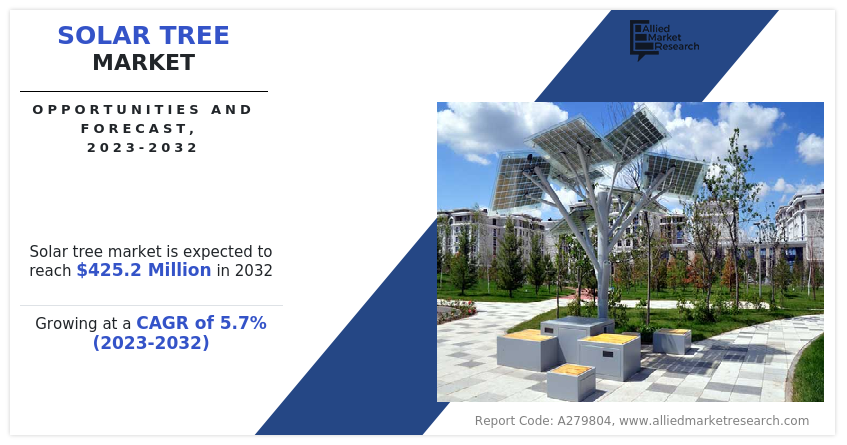
Solar trees enable individuals and businesses to produce electricity. This provides a level of energy independence, reducing reliance on centralized power grids and traditional energy sources. In times of grid failures or power outages, solar trees can continue to provide electricity, increasing energy security. Moreover, solar trees offer long-term financial benefits by reducing energy costs. By generating their own electricity, users can save money on their utility bills and potentially earn income through net metering or feed-in tariffs. This financial incentive encourages the adoption of solar tree technology. Governments of various countries offer incentives, tax credits, and subsidies to promote the adoption of solar energy systems, including solar trees. These incentives reduce the upfront costs of installation and make solar trees more affordable for consumers and businesses. In some regions, there are concerns about the reliability of traditional energy sources, including the potential for energy supply disruptions due to extreme weather events or geopolitical instability. Solar trees can contribute to energy security by providing a decentralized and reliable source of energy. Furthermore, solar trees are often designed with aesthetics in mind, making them suitable for urban environments. They can serve dual purposes by providing clean energy while enhancing the visual appeal of public spaces and commercial areas.
A significant obstacle faced by solar trees lies in their comparably high cost when juxtaposed with traditional solar PV modules. Despite the decreasing costs witnessed in the solar panel industry in recent years, solar trees remain relatively expensive. For instance, a 1.8 kW solar tree might be priced at approximately $40,000, and larger 5.4 kW units can extend up to $80,000. When considering commercial-grade solar trees with capacities of 16.5 kW, the cost may escalate to as much as $100,000. This financial constraint poses a challenge to the widespread adoption of solar trees, rendering them less accessible to a broader spectrum of users when contrasted with traditional solar panels.
Solar tree technology has been evolving rapidly, with improvements in solar panel efficiency, energy storage solutions, and smart grid integration. This opens opportunities for more efficient and cost-effective solar tree designs, making them a compelling choice for renewable energy generation. Urban areas are experiencing continuous growth, and space is often limited. Solar trees can be integrated into urban environments, offering a dual benefit of energy generation and urban greenery. As cities expand, the demand for renewable energy sources that fit within the urban landscape is expected to grow. Furthermore, solar trees are not only functional but also aesthetically pleasing. They can serve as landmarks or public art installations, making them attractive options for urban planners and developers. Incorporating renewable energy into visually appealing structures can enhance the public's perception of sustainability. Major countries across the globe are actively transitioning to renewable energy sources to reduce carbon emissions and combat climate change. Solar trees can contribute to meeting clean energy targets, and this growing focus on sustainability creates a favorable market environment. Various governments offer incentives, tax credits, and subsidies for renewable energy projects, including solar trees. These financial incentives can make solar tree installations more economically viable and attractive for businesses and homeowners.
The key players profiled in solar tree market forecast include Beam Global, Smartflower, SolarBotanic Trees Ltd, Solvis, Solar Forma, Spotlight Solar, Power Tree, IYSERT ENERGY, NESSA, and ARTEMIDE S.P.A. Investment and agreement are common strategies followed by major market players. For instance, in 2022, SolarBotanic Trees announced the introduction of its groundbreaking 'solar tree,' crafted to provide both aesthetic appeal and sustainable energy. It was ideally tailored for large-scale commercial environments, including flagship office sites and sports stadiums.
The solar tree market is segmented on the basis of connectivity, component, application, and region. By connectivity, the market is divided into on-grid and off-grid. By component, the market is classified into solar PV modules, battery, cables & connectors, and others. By application, the market is classified into residential, commercial & industrial, and utilities. By region, the market is analyzed across North America, Europe, Asia-Pacific, and LAMEA.
The solar tree market is segmented into Application, Connectivity and Component.
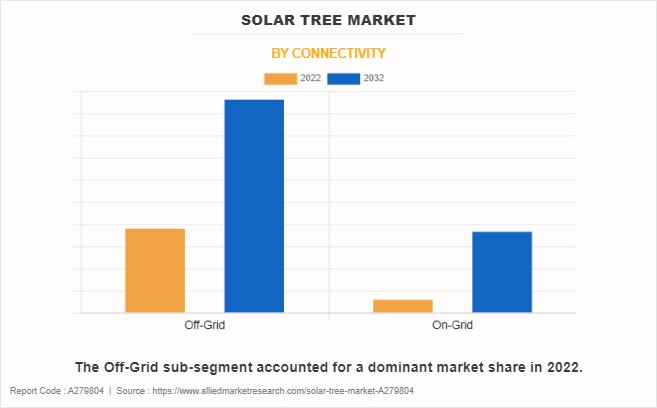
By connectivity, the off-grid, sub-segment dominated the market in 2022. Increasing awareness regarding environmental issues and the need to reduce carbon emissions has led to a rise in demand for renewable energy sources. Off-grid solar trees align with these concerns, as they generate electricity from solar power, a clean and sustainable source. Moreover, in some remote areas, it can be difficult and expensive to extend the traditional grid infrastructure. Off-grid solar trees offer a decentralized and cost-effective way to provide electricity to such regions, addressing energy access challenges. Government incentives, subsidies, and favorable policies promote the adoption of solar energy systems, including off-grid solutions. Various federal and local programs encourage the deployment of renewable energy technologies, making solar trees more attractive to investors and end-users. In addition, off-grid solar trees provide energy independence, allowing users to generate their own electricity and reduce reliance on conventional power sources. This self-sufficiency is an appealing feature, particularly for rural and remote communities. Advances in solar panel technology, battery storage, and energy management systems have improved the efficiency and reliability of off-grid solar systems. These advancements make solar trees a more viable and competitive energy solution. These are predicted to be the major factors affecting the solar tree market size during the forecast period.
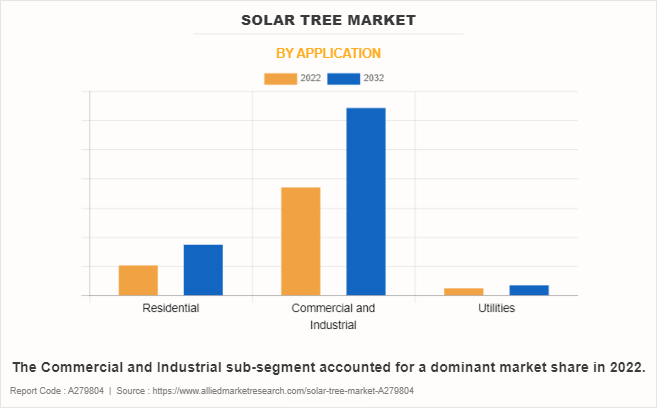
By application, the commercial & industrial, sub-segment dominated the global solar tree market share in 2022. The commercial and industrial solar tree market witnesses a significant impact due to the increased adoption of solar trees. These structures, seamlessly integrating solar panels with an appealing tree-like design, are gaining widespread popularity for their capacity to generate renewable energy while offering shade and a distinctive visual allure. Many countries globally have established renewable energy goals and regulations to reduce carbon emissions. Solar trees emerge as instrumental tools for businesses and industries to align with these objectives by harnessing sustainable energy. Furthermore, governments and local authorities universally offer financial incentives and subsidies to promote the adoption of solar technology, including tax credits, rebates, and feed-in tariffs. These incentives enhance the financial appeal of solar tree installations, and the potential for significant energy cost savings remains a strong driver for commercial and industrial businesses to invest in solar trees. By generating electricity, these businesses can curtail their dependence on grid power and lower their energy bills. These factors are anticipated to boost solar tree market growth.
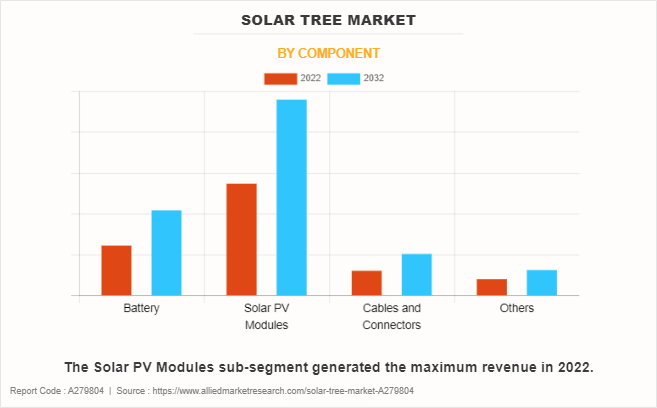
By component, the solar PV modules sub-segment dominated the global solar tree market share in 2022. Solar PV modules empower individuals and organizations to generate their electricity, diminishing reliance on traditional utility grids. Solar trees provide an aesthetically pleasing means to achieve this energy independence. Ambitious renewable energy targets have been set globally, with governments and organizations actively promoting solar energy adoption. Solar trees, with their unique and visually appealing designs, emerge as an attractive option. Increasing awareness of climate change and environmental concerns fuels the demand for clean energy sources. Solar PV modules integrated into solar trees offer a sustainable and eco-friendly energy solution, aligning with environmental consciousness worldwide. Solar trees, seamlessly blending into urban and rural environments, present an innovative way to incorporate solar power generation into public spaces, parks, parking lots, and other areas. This adaptability makes them popular in regions with strict zoning and aesthetic requirements. Solar PV modules can significantly reduce electricity bills for homes and businesses. As the cost of solar technology declines, the financial incentive to invest in solar trees becomes even more attractive. Various financial incentives and subsidies, such as tax credits and feed-in tariffs, are available globally to promote solar energy adoption and can substantially reduce the upfront costs of installing solar PV modules.
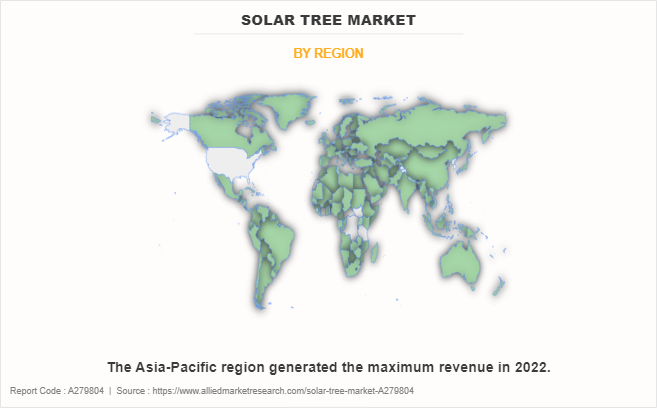
By region, Asia-Pacific dominated the global market in 2022 and is projected to be the fastest-growing sub-segment during the forecast period. Asia-Pacific is currently undergoing rapid economic growth and urbanization, leading to a substantial upswing in energy requirements. Solar power, featuring technologies like solar tree, emerges as a viable solution to address the escalating demand for renewable and sustainable energy. Consequently, there exists a robust market demand for solar trees in the region, reflecting the imperative to meet the burgeoning energy needs. The continuous reduction in the manufacturing costs of Solar Trees, attributed to technological advancements, economies of scale, and heightened competition, has significantly enhanced the affordability and competitiveness of solar energy in comparison to traditional sources. This, in turn, is projected to boost the demand for solar tree in Asia-Pacific.
Impact of COVID-19 on the Global Solar Tree Industry
- The solar tree market has witnessed a significant impact from the COVID-19 pandemic. The global supply chains, encompassing the production and transportation of components for solar panels, experienced disruptions. Lockdown measures, international trade restrictions, and temporary closures of factories in various countries had repercussions on the supply of raw materials and manufacturing processes, potentially affecting the production and availability of solar trees.
- The economic uncertainty and reduced spending by consumers and businesses induced by the COVID-19 pandemic could have influenced the solar market, including the demand for solar trees. The pandemic may have led to delays or cancellations of solar projects, decreased investments in renewable energy, and overall market uncertainty, potentially impacting the demand for solar trees.
- The implementation of movement restrictions and social distancing measures during the pandemic may have presented challenges to the installation of solar panels, including PERC panels. Limited access to installation sites, a shortage of skilled labor, and delays in obtaining necessary permits could have affected the execution of solar projects, thereby impacting the demand for PERC panels.
- The solar energy industry at large faced disruptions initially due to the pandemic, affecting the supply chain, manufacturing, and project installations. Lockdown measures, travel restrictions, and reduced workforce availability led to delays and temporary setbacks in the solar industry, including the solar tree market.
Key Benefits For Stakeholders
- This report provides a quantitative analysis of the market segments, current trends, estimations, and dynamics of the solar tree market analysis from 2022 to 2032 to identify the prevailing solar tree market opportunities.
- The market research is offered along with information related to key drivers, restraints, and opportunities.
- Porter's five forces analysis highlights the potency of buyers and suppliers to enable stakeholders make profit-oriented business decisions and strengthen their supplier-buyer network.
- In-depth analysis of the solar tree market segmentation assists to determine the prevailing market opportunities.
- Major countries in each region are mapped according to their revenue contribution to the global market.
- Market player positioning facilitates benchmarking and provides a clear understanding of the present position of the market players.
- The report includes the analysis of the regional as well as global solar tree market trends, key players, market segments, application areas, and market growth strategies.
Solar Tree Market Report Highlights
| Aspects | Details |
| Market Size By 2032 | USD 425.2 million |
| Growth Rate | CAGR of 5.7% |
| Forecast period | 2022 - 2032 |
| Report Pages | 283 |
| By Application |
|
| By Connectivity |
|
| By Component |
|
| By Region |
|
| Key Market Players | Power Tree, SolarBotanic Trees Ltd, Solar Forma, IYSERT ENERGY, Beam Global, Solvis, NESSA, Spotlight Solar, ARTEMIDE S.P.A., Smartflower |
The global push for renewable energy sources, driven by environmental concerns and climate change mitigation, is a major driver for the solar tree market.
The major growth strategies adopted by solar tree market players are investment and agreement.
Asia-Pacific will provide more business opportunities for the global solar tree market in future.
Beam Global, Smartflower, SolarBotanic Trees Ltd, Solvis, Solar Forma, Spotlight Solar, Power Tree, IYSERT ENERGY, NESSA, and ARTEMIDE S.P.A. are the major players in the solar tree market.
The solar PV modules sub-segment of the component segment acquired the maximum share of the global solar tree market in 2022.
Commercial, industrial, and residential sectors are the major customers in the global solar tree market.
The report provides an extensive qualitative and quantitative analysis of the current trends and future estimations of the global solar tree market from 2022 to 2032 to determine the prevailing opportunities.
Loading Table Of Content...
Loading Research Methodology...



